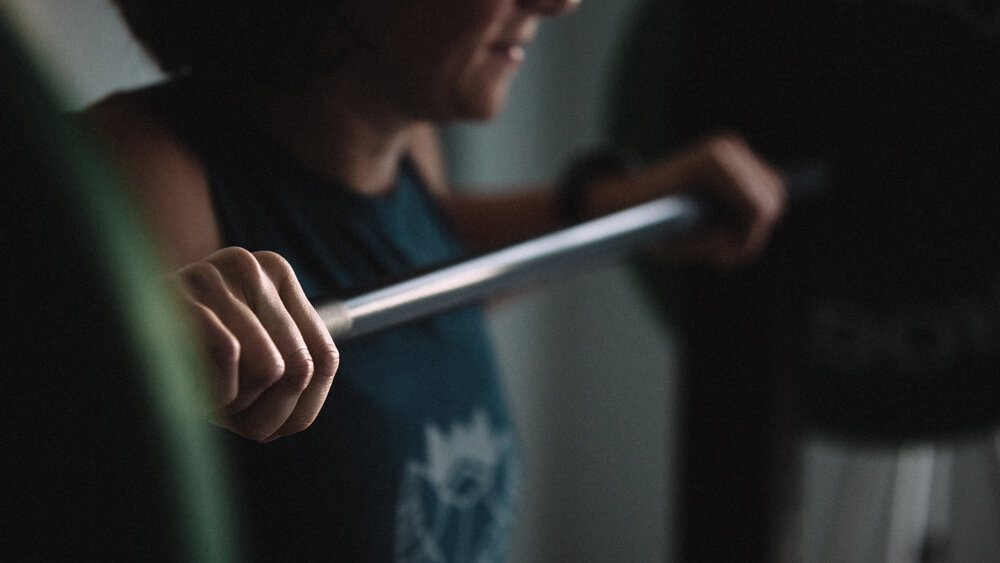As a physio who works with athletes, many of which are women, teaching the hip hinge and deadlift is essential. I use it with almost every single athlete in pain. For a number of reasons. Including, that this lift, unlike many others, works basically all the things: the shoulders, back, hips, hamstrings, knees, ankles, feet. Pretty much all of it. But with a fair bit of time working in sports, I have found that women are either uncomfortable with the hinging exercise, or simply nervous about doing it with a lot of load. Others, are frankly, afraid of the bar.
Being afraid of the bar is totally normal, particularly when you haven’t been trained how to perform the lifts in a way that maximizes the use of the proper musculature. The truth of the matter though, is that no matter how you try to pick up a bar for a deadlift (despite what some will tell you), you WILL eventually adapt and it will get easier. While lifting mechanics can be helpful towards optimizing your muscle recruitment, there is little to show us that “poor” lifting mechanics actually harms us. So, I’m going to take this quick opportunity and say that perfect lifting technique is not required to perform a deadlift.
As a new face at the gym, I remember heading towards the bar and feeling utterly embarrassed about my lack of skill. And I say that, as a physiotherapist and as a previously trained division I athlete who was lifting weights regularly and using the bar regularly. Gym-timidation is real, particularly for women. As with anything though, when it comes to lifting or recovering from injury, I encourage the mantra “don’t let fear stop you.” Movement exploration and curiosity are the spice of life.
““Don’t let fear stop you.” Movement exploration and curiosity are the spice of life” — Dr. Ellie Somers
Here, I aim to help you gain confidence with the deadlift. To give you some tools to practice with and to help get yourself moving towards the incredible feeling of pulling a heavy or heavy-ish weight off the ground.
1) Practice first
The first thing that I recommend is simply practicing the movement of the hip hinge. You can do this using a pvc pipe as seen in the picture below. Most gyms should have these handy, but if they don’t, a nice broom stick at home works wonders. You’ll want to put the PVC pipe along your spine, touching your head, between your shoulder blades, and your tailbone. Keeping the pipe in contact with each touch point, you’ll drop your shoulders forward and push your hips backwards.
If you do this movement and attempt to keep your knees straight, you’ll notice a little tension that might build in the back of your legs, specifically your hamstrings. In the deadlift we want to optimize that tension, but bringing your hamstrings to a full stretch like this doesn’t end up providing them with the best way to contribute to the motion. As such, when you start to hinge, you also want to think about slightly bending your knees. That will help to shorten the hamstrings, bringing them into their optimal position for maximal loading.
What I’ve noticed in rehab, is that this is where folks can start to get a little confused. I often see the tendency for an athlete to fall into a squat BEFORE they hinge. Ultimately this is seen when an athlete bends the knees first, instead of the hinging the hips. The deadlift is not a squat, but can be confused for a squat when the movement technique being used isn’t maximizing the use of your muscles in the boot-ay. So, work towards diving those hips back FIRST when you’re practicing.
2) Add load slowly
Once you’ve practiced the hinging motion with a PVC pipe, it’s time to add a little load. You can do this a number of ways, but an easy starting point is with a weighted bar. This just a heavy-ish bar found in most gyms. You’ll still get the feel of holding a barbell, while also adding a little load. You can practice this movement, by propping the weighted bar onto two stair steps and then moving into your deadlift/hinge position and pulling it upward.
Adding weight slowly can help you gain confidence, as well as help to build tissue tolerance, giving your body time to adapt. By doing so, when you approach the barbell for the first time, you won’t be in a situation that makes you unable to walk the next day. As long as you are relatively consistent with your practice lifting weights, you’ll likely be able to lift the weight of a barbell (typically 45 pounds), in no time.

3) Lift the barbell
Once you’ve had the opportunity to practice with the pipe and the weighted bar, you can now consider moving to the barbell. Lifting the bar is exactly like what you’ve practiced and now you’re ready. The movements are the same, so continue practicing under the new and heavier load in a way that feels good to you. Practice makes progress, not perfection.
“Practice makes progress NOT perfection”
Picture on the left: December 2016, Picture on the right: July 2017
There is nothing quite like the feeling of lifting a heavy object off the ground. As you progress and gain confidence with the bar itself, you can start to slowly add weight at a level that feels good for you. Adding weight will also facilitate muscle recruitment where you want it…the lower back, the glutes and the hamstrings. But now, you have the confidence and wherewithal to do it and feel like the badass that you really are!! Remember, this all takes time! Strength gains and confidence to use the barbell don’t happen overnight, but with consistency and commitment they will.
**It would be advised that if you DO have an injury, you consult with your physio or medical provider before you attempt to lift something heavy.**
Thanks for reading!!
Cheers all,
Dr. Ellie Somers
Your sports physiotherapist
Sisu Sports Performance & PT is accepting new clients and we would love to help you get back to doing what you love!! Feel free to send me an email or schedule an appointment today!






